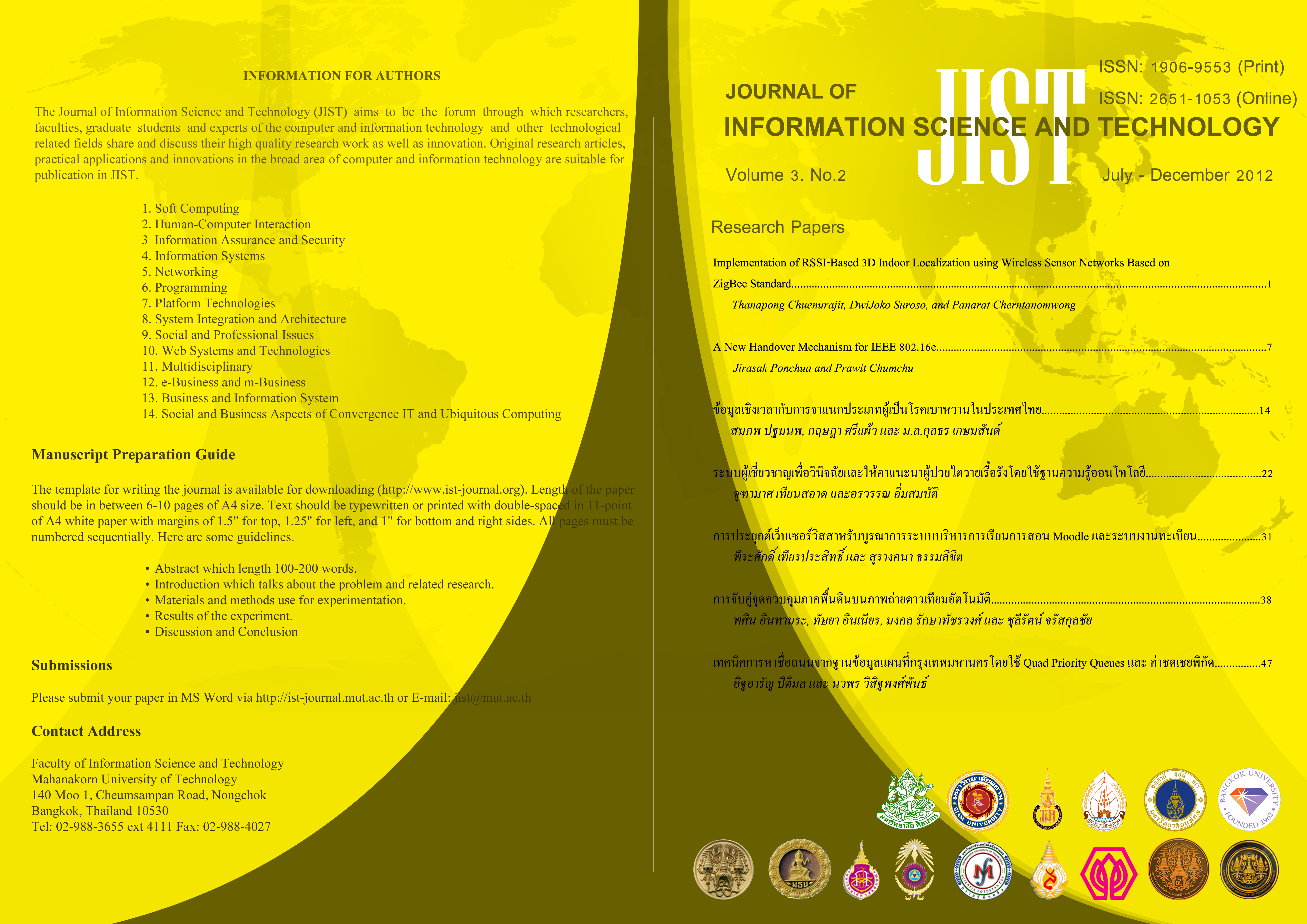Implementation of RSSI-Based 3D Indoor Localization using Wireless Sensor Networks Based on ZigBee Standard
Main Article Content
บทคัดย่อ
- Indoor localization as a part of the wireless node localization has its advantages to be applied in the real life. Complicated terrain and environments in an indoor environment become the proposed problems in this research. This paper proposes a simple and effective system for Wireless Sensor Networks-based 3D indoor localization based on ZigBee standard. A clean environment as the observed areaof 5 m × 5 m × 2 m is applied. The Min-Max algorithm as one of the techniques in the range-based localization is employed. The 8 reference nodes are deployed. The target node is stationary in the observed location. The expected estimated location error of the target should be less than the experiment areas, so that less than 2 m for our case. The results show that the estimated errors of all observed target locations are less than 2 m, which are satisfied our expectation. The proposed technique will be developed to improve the accuracy to support all applications for the future.
Article Details
This work is licensed under a Creative Commons Attribution-NonCommercial-NoDerivatives 4.0 International License.
I/we certify that I/we have participated sufficiently in the intellectual content, conception and design of this work or the analysis and interpretation of the data (when applicable), as well as the writing of the manuscript, to take public responsibility for it and have agreed to have my/our name listed as a contributor. I/we believe the manuscript represents valid work. Neither this manuscript nor one with substantially similar content under my/our authorship has been published or is being considered for publication elsewhere, except as described in the covering letter. I/we certify that all the data collected during the study is presented in this manuscript and no data from the study has been or will be published separately. I/we attest that, if requested by the editors, I/we will provide the data/information or will cooperate fully in obtaining and providing the data/information on which the manuscript is based, for examination by the editors or their assignees. Financial interests, direct or indirect, that exist or may be perceived to exist for individual contributors in connection with the content of this paper have been disclosed in the cover letter. Sources of outside support of the project are named in the cover letter.
I/We hereby transfer(s), assign(s), or otherwise convey(s) all copyright ownership, including any and all rights incidental thereto, exclusively to the Journal, in the event that such work is published by the Journal. The Journal shall own the work, including 1) copyright; 2) the right to grant permission to republish the article in whole or in part, with or without fee; 3) the right to produce preprints or reprints and translate into languages other than English for sale or free distribution; and 4) the right to republish the work in a collection of articles in any other mechanical or electronic format.
We give the rights to the corresponding author to make necessary changes as per the request of the journal, do the rest of the correspondence on our behalf and he/she will act as the guarantor for the manuscript on our behalf.
All persons who have made substantial contributions to the work reported in the manuscript, but who are not contributors, are named in the Acknowledgment and have given me/us their written permission to be named. If I/we do not include an Acknowledgment that means I/we have not received substantial contributions from non-contributors and no contributor has been omitted.
เอกสารอ้างอิง
2. M. Balt, H. Xue, W. Shen, and H. Ghenniwa, “A 3-D indoor location tracking and visualization based on wireless sensor networks,” in IEEE International Conference on Systems Man and Cybernetics, Turkey, Oct. 2010, pp. 1584-1590.
3. D. J. Suroso, P. Cherntanomwong, P. Sooraksa, and J. Takada, “Location fingerprint technique using fuzzy C-means clustering algorithm,” in TENCON 2011, Indonesia, Nov. 2011, pp. 88-92.
4. N. Nakarach, T. Bokam, K. Jomprom, D. J. Suroso, and P. Cherntanomwong, “Implementation of RSSI-based localization system using wireless sensor networks based on ZigBee standard,” in Regional Conference on Information and Communication Technology, Lao PDR, Mar. 2011.
5. A. Savvides , H. Park, and M. Srivastava, “The bits and flops of the N-hop multilateration primitive for node localization problems,” in The first ACM International Workshop on Wireless Sensor Networks and Application, Atlanta, Sep. 2002, pp. 112–121.
6. F. Su, W. Ren, and H. Jin, “Localization algorithm based on difference estimation for wireless sensor networks,” in International Conference on Communication Software and Networks, Feb. 2009, pp. 499-503.
7. R. Grossmann, J. Blumenthal, F. Golatowski, and D. Timmermann, “Localization in ZigBee-based sensor networks,” Technical Report (German), University of Rostock, Institute MD, Apr. 2007.
8. S.Karni, “A simple geometry of Euclidean Norms,” IEEE Trans. Education, vol. 31, no. 2, pp.140, May 1988.



